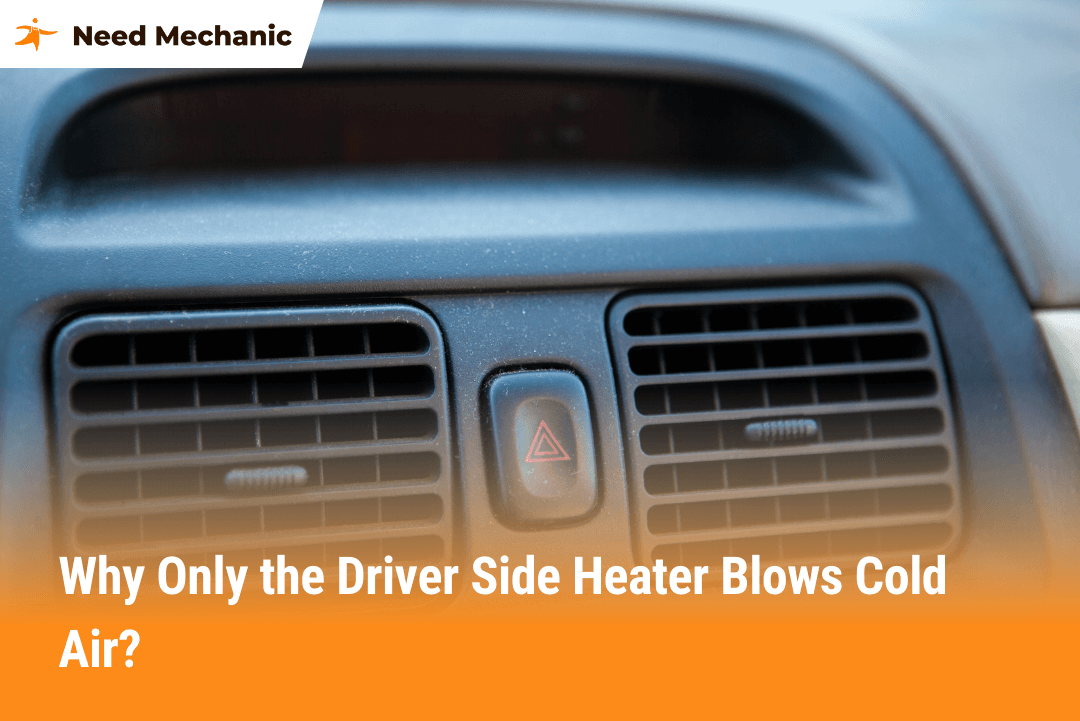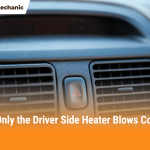Your car heater blows cold air on the driver’s side because something is stopping hot coolant or heated air from reaching that part of the system. The most common causes include low coolant, a stuck blend door actuator, or a clogged heater core. These issues create uneven airflow so the passenger side may still get heat while the driver’s side stays cold.
Instead of just being uncomfortable, this problem can signal bigger issues in your cooling system. In this guide, we’ll explain the most common causes, how to spot them, and what you can do to fix it so your car heats evenly again.
Table of Contents
How Your Car Heater Works (Quick Overview)
Before diving into the issues, it helps to understand how your car’s heater system works. Unlike a household heater, your car doesn’t have a separate heating unit. Instead, it uses hot coolant from the engine to warm the air. That hot coolant passes through the heater core, a small radiator inside the dash. A blower fan pushes air over it, and that air flows into the cabin.
When one side of the car blows hot and the other blows cold, it usually means something is preventing the hot coolant or heated air from reaching one part of the system. That’s why this issue is often related to blocked passages, stuck doors, or uneven coolant flow.
Common Causes of Cold Air on the Driver’s Side
1. Low Coolant Levels
Coolant is the lifeblood of your heating system. If the coolant is too low, there may not be enough fluid circulating through the heater core. This often leads to uneven heating where the passenger side gets warmth but the driver side stays cold.
What to do: Check your coolant reservoir and radiator (when the engine is cold). If the coolant is low, top it off with the correct type for your vehicle. But remember—if it’s low, there may be a leak that needs repair.
2. A Clogged or Partially Blocked Heater Core
Over time, rust, scale, and debris can build up inside the heater core. This blocks coolant flow and prevents heat from reaching one side of the cabin.
Signs to watch for:
- Foggy windows with a sweet smell (coolant vapor).
- One side of the car blowing cold, the other hot.
- Engine overheating or fluctuating temperatures.
What to do: A professional flush of the heater core may restore flow. In severe cases, the heater core may need replacing.
3. Blend Door Actuator Problems
Inside your dashboard are small doors called blend doors. These doors control how hot or cold air is directed into the cabin. When the actuator that moves the driver’s side blend door fails, it may get stuck in the “cold” position, leaving only that side blowing cold.
What to do: Listen for clicking noises behind the dash when adjusting temperature controls. If you hear it, the actuator is likely failing. Replacing the blend door actuator usually fixes the issue.
4. Faulty Thermostat
The thermostat controls engine temperature by regulating coolant flow. If it’s stuck open, your engine may run cooler than normal, which means lukewarm or cold air from the heater—especially noticeable on the driver’s side.
What to do: If your dashboard gauge shows the engine is running cooler than usual, replacing the thermostat can restore proper heat.
5. Air Pockets in the Cooling System
When air gets trapped inside the cooling system, it prevents coolant from circulating evenly. This can result in one side of the heater core being hot while the other stays cold.
What to do: Bleeding the cooling system removes trapped air. This is often done after a coolant flush or radiator repair.
Why Fixing This Problem Matters
Ignoring a car heater that only blows cold air on the driver’s side is more than just an inconvenience. Here’s why fixing it is important:
- Comfort: No one wants to drive shivering while passengers are comfortable.
- Safety: A functioning heater is critical for defrosting your windshield and maintaining visibility.
- Prevention: Problems like low coolant or a blocked heater core can lead to bigger issues, including engine overheating and costly repairs.
By fixing the root cause, you protect both your comfort and your car’s long-term health.
Step-by-Step Troubleshooting Guide
- Check Coolant Level – Make sure the reservoir and radiator are full.
- Inspect for Leaks – Look under the car and around the engine bay.
- Run the Heater at Different Settings – Listen for unusual noises from the dash.
- Monitor Engine Temperature – Watch the dashboard gauge for overheating or running too cold.
- Consult a Mechanic if Needed – If the problem isn’t obvious, a professional can perform a pressure test, heater core flush, or actuator replacement.
Preventing Future Heater Problems
Keeping your car heater in good shape comes down to regular maintenance. Here are a few simple habits:
- Flush your coolant system every 2–3 years.
- Use the correct type of coolant for your vehicle.
- Fix leaks as soon as they appear.
- Run your heater a few times in warmer months to keep parts moving.
These small steps save you from the surprise of a cold driver’s side heater on a freezing morning.
Conclusion
When your car heater is blowing cold air on the driver side, it’s a sign that something in your cooling or ventilation system needs attention. The most common culprits are low coolant, a clogged heater core, blend door actuator failure, thermostat issues, or air pockets in the system.
By learning the causes and solutions, you can either handle small fixes yourself or know exactly what to discuss with your mechanic. Solving this issue restores your comfort, keeps your windshield clear, and protects your engine from bigger problems down the road.
FAQs
Why is my car heater blowing cold air only on one side?
This usually happens due to low coolant, a stuck blend door actuator, or a partially clogged heater core.
Can I drive if my heater only works on the passenger side?
Yes, but it’s uncomfortable and may be unsafe in winter because it can affect windshield defrosting.
How do I know if the blend door actuator is bad?
You may hear clicking sounds from the dash or notice that temperature controls don’t respond on one side.
Will adding coolant fix the problem?
If low coolant is the cause, yes. But if the coolant keeps dropping, you may have a leak that needs repair.
How much does it cost to fix a heater blowing cold air on one side?
Costs vary. A coolant top-up is cheap, while replacing a blend door actuator or heater core can cost several hundred dollars.
Can air bubbles cause uneven heating?
Yes. Air pockets in the cooling system prevent proper coolant flow and cause one-sided cold air.
How often should I flush my coolant system?
Most manufacturers recommend every 2–3 years, but always check your vehicle’s manual.




Leave a Reply